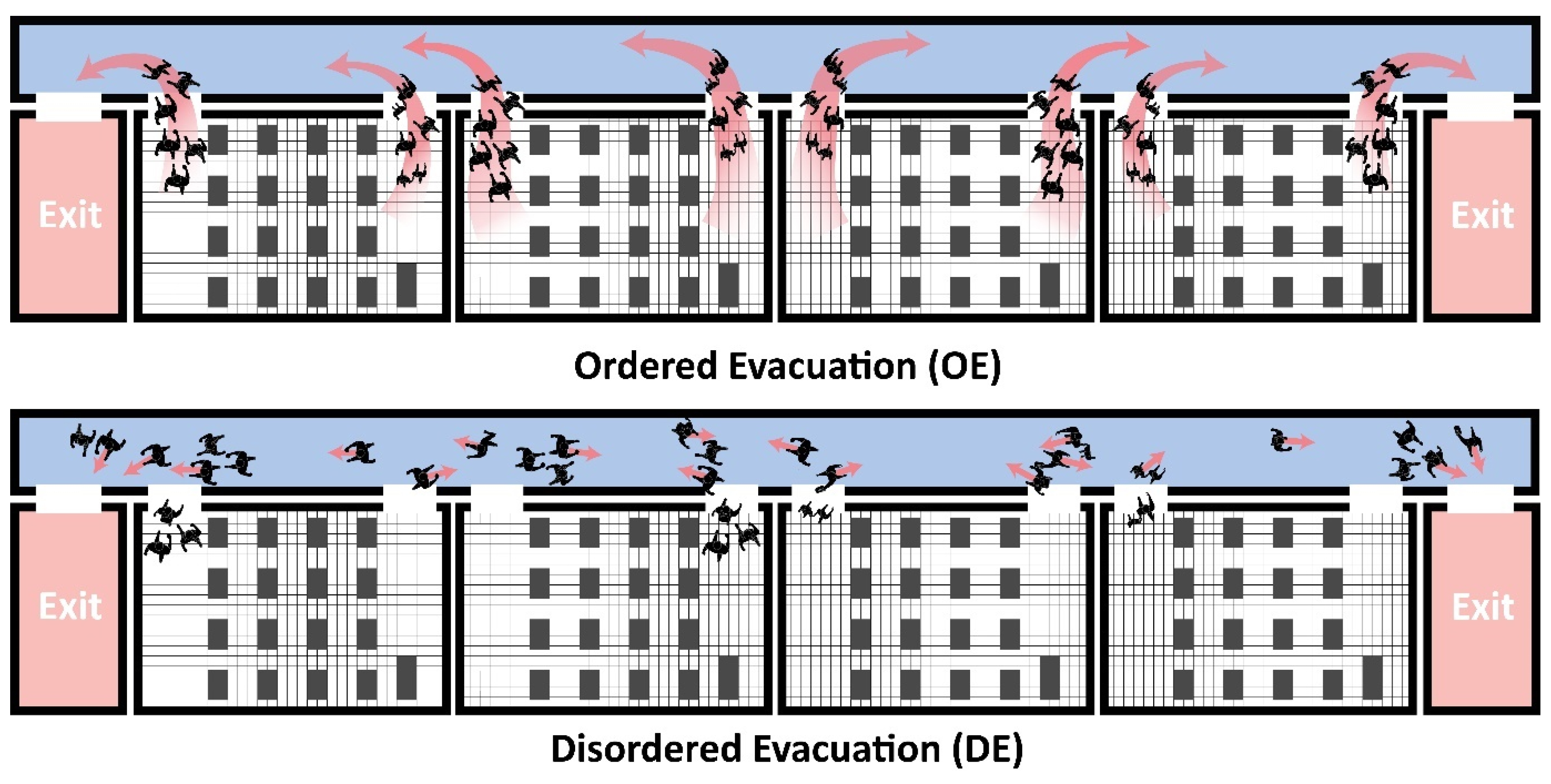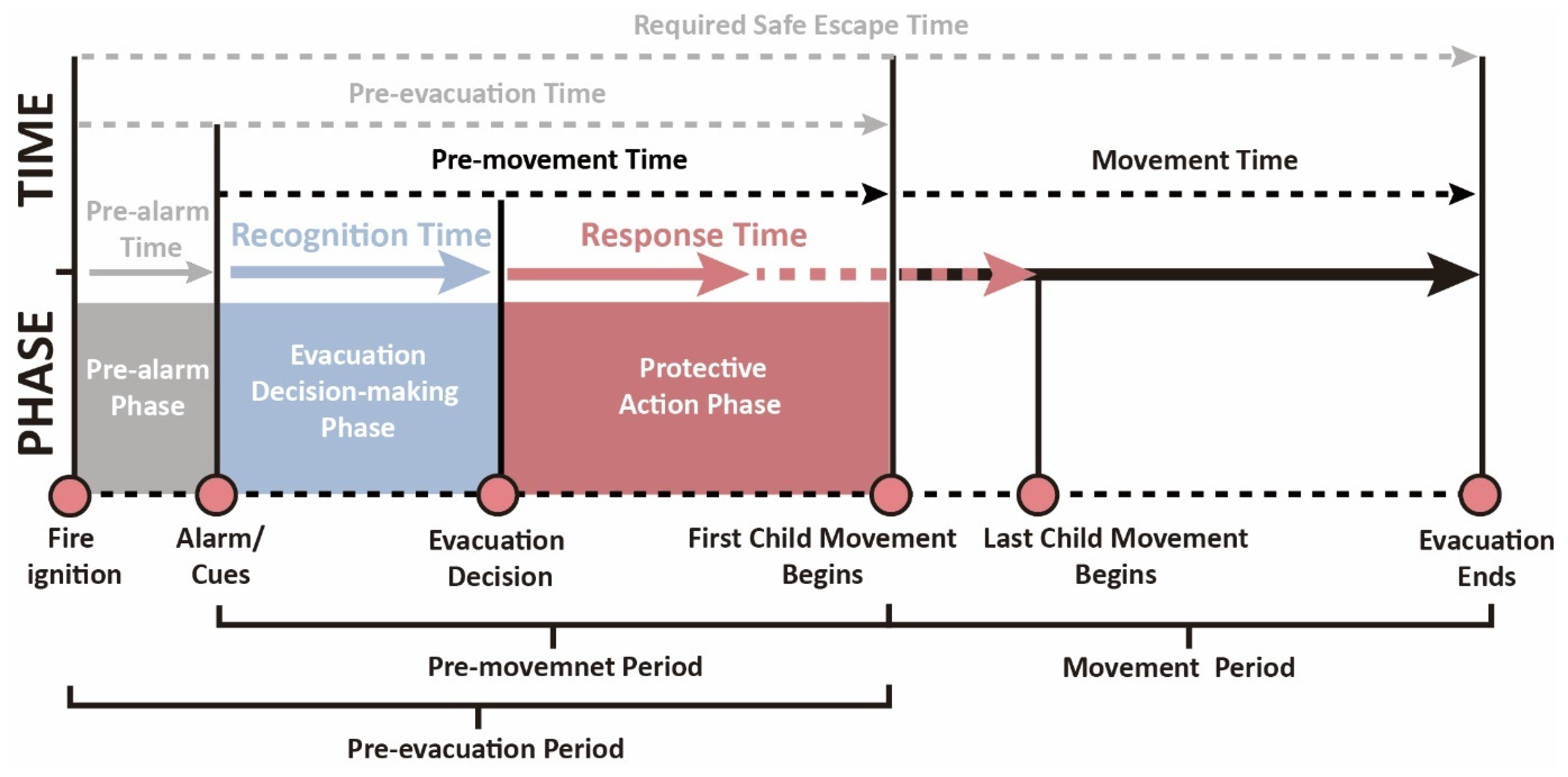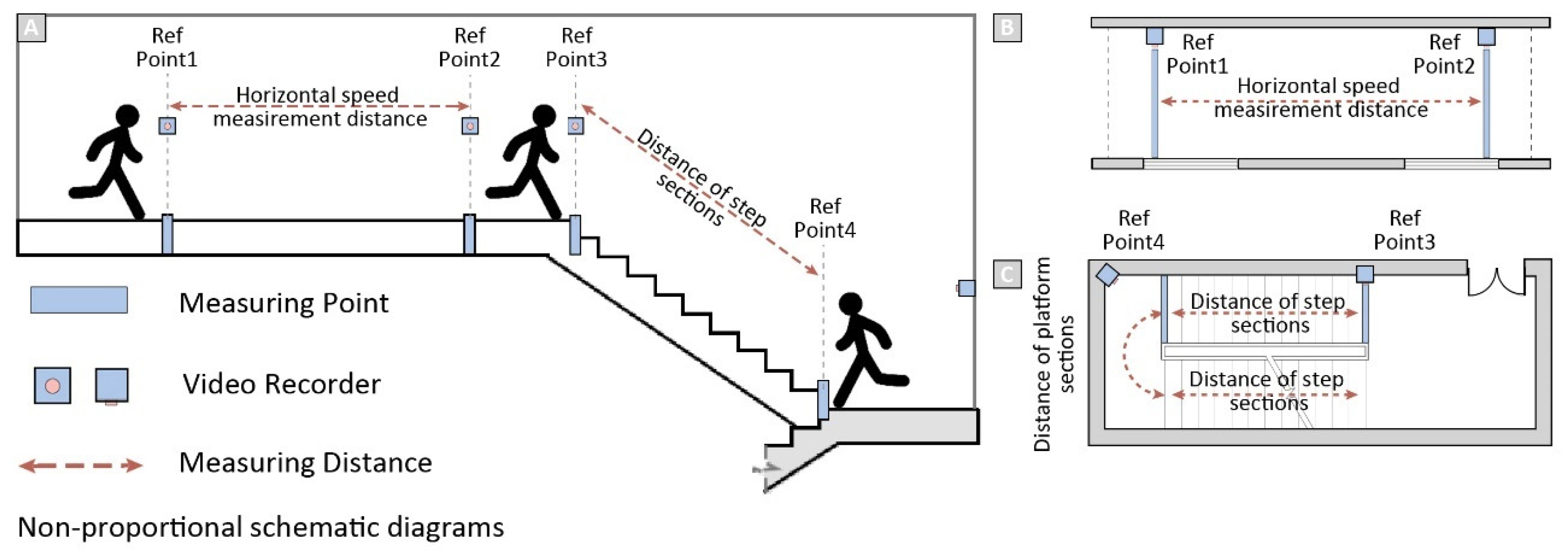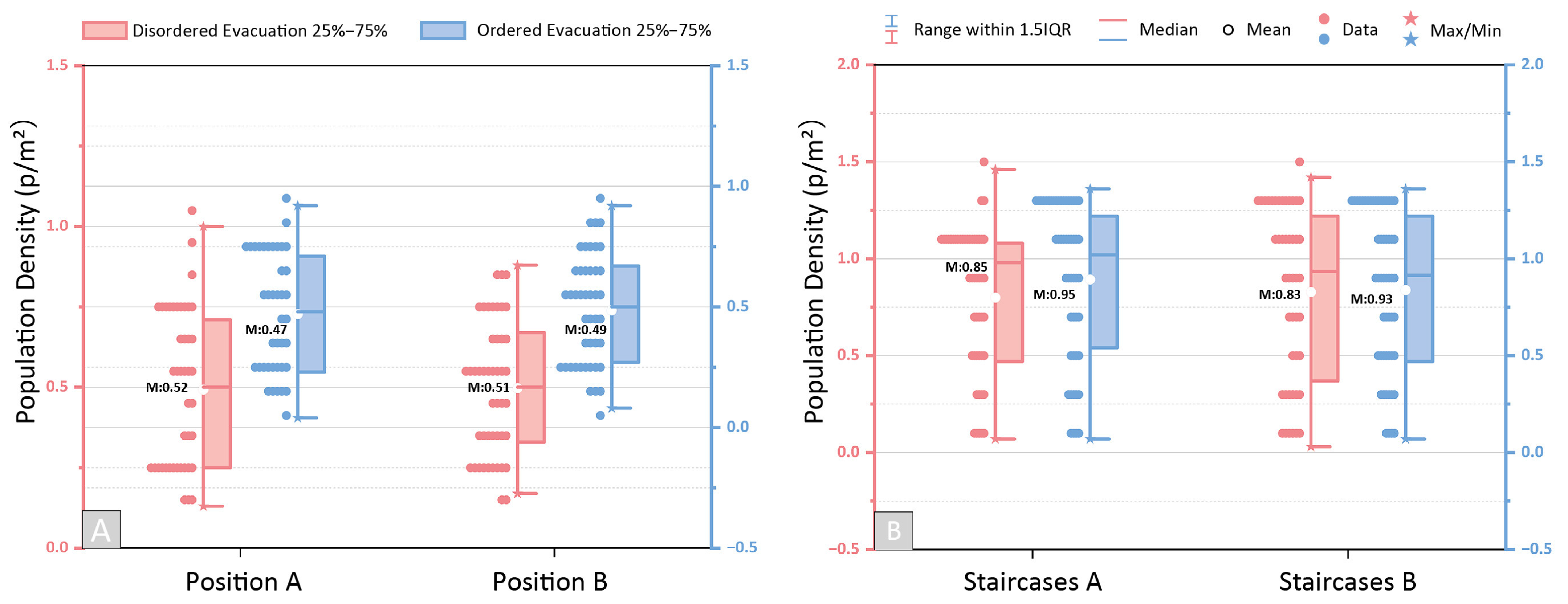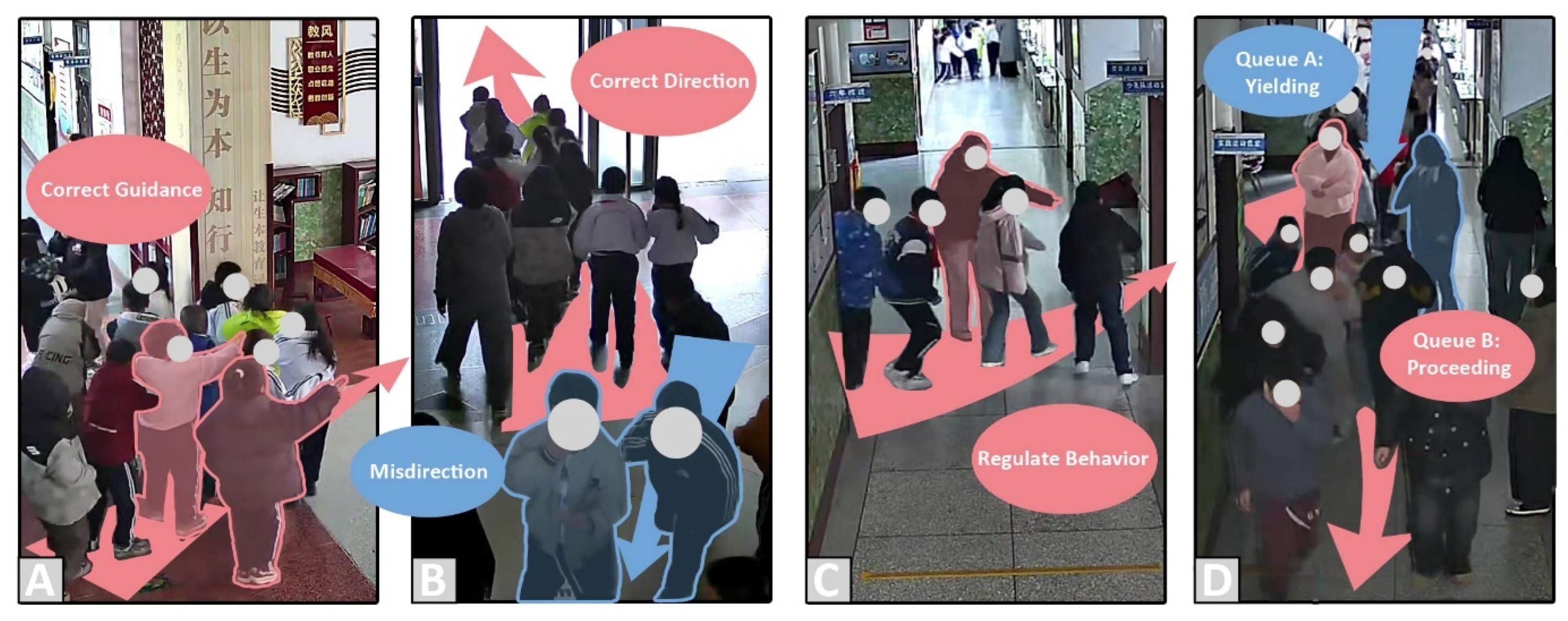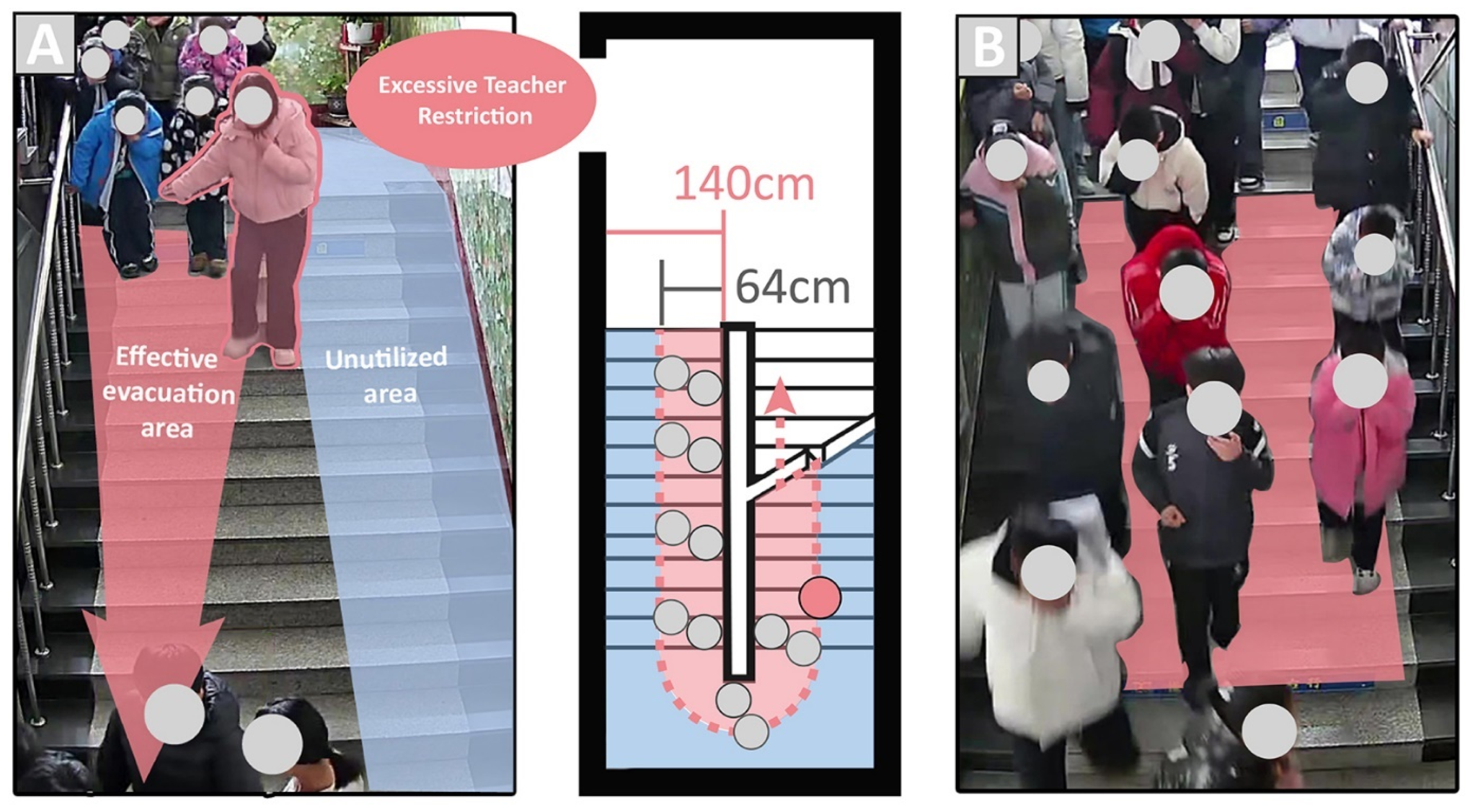1. Introduction
In China, more than 125 million school-aged children account for over 8.9% of the national population. As a vulnerable group in emergency evacuations, their safety has drawn increasing attention [
1]. Owing to immature physiological and cognitive development, they are more susceptible than adults to movement speed, environmental perception, and risk response, placing them at greater safety risk during emergencies [
2,
3].
In emergency evacuations, architectural design alone cannot guarantee rapid and safe egress. Therefore, adopting appropriate evacuation forms is essential to enhance efficiency and reduce risks. Evacuation forms refer to the organizational methods and flow patterns adopted by crowds in emergency conditions [
4]. Based on factors such as population size, building layout, and event characteristics, common forms include ordered, disordered, phased, guided, and reverse evacuations [
5,
6,
7]. Among these, ordered and disordered evacuations are the most widely applied owing to their structural simplicity and broad applicability. Ordered evacuation is a planned process guided by unified commands and predetermined routes, whereas disordered evacuation lacks centralized control and relies on individual judgment and autonomous action [
5]. The differences between these two forms are illustrated in
Figure 1, and the comparison of different evacuation forms can be found in
Table S1.
Primary school buildings are typical high-density public facilities occupied by vulnerable children and are particularly sensitive to external evacuation forms [
8]. In group-based evacuations organized by class units, appropriate organizational strategies influence children’s movement patterns and can significantly enhance overall evacuation efficiency [
9]. Recent studies have primarily focused on the individual-level evacuation behaviors of school-aged children, encompassing aspects such as movement characteristics, perceptual responses, and environmental influences. Experimental findings have demonstrated that children’s movement speed and coordination vary according to age, crowd density, and building configuration, thereby affecting overall evacuation efficiency [
10,
11]. Beyond physical ability, perceptual and cognitive factors also play a crucial role. For instance, variations in alarm sounds can alter children’s physiological responses and risk perception, subsequently influencing the initiation of evacuation [
12]. Studies based on field observations and video-based analyses have further revealed that, under stressful or spatially constrained conditions, children often display hesitation, peer-following, and local clustering behaviors [
13,
14]. Although these studies have substantially advanced the understanding of children’s individual evacuation behaviors, systematic investigations into how grouping behaviors influence evacuation efficiency under ordered and disordered evacuation forms remain limited.
School-aged children, defined as those aged 6–12, typically show strong dependence on and responsiveness to external guidance [
15]. In evacuation scenarios, their movement rhythms and route choices often exhibit collective tendencies, known as “grouping behavior”. This involves forming stable or temporary units in which individuals travel in close proximity, follow the same direction, and maintain similar paces [
16]. Analyses of real-world disasters indicate that such behavior is often driven by social ties, such as family, friendship, or class affiliation, and shaped by both individual decision-making and environmental constraints [
17,
18,
19]. Studies of adult pedestrians by Moussaïd et al. showed that socially bonded groups adjusted their spatial structures to reduce interference in dense environments, reflecting strong social motivations [
20]. Similarly, Ding and Sun found that students often formed small, unstable groups of two or three, typically following peers or leaders rather than relying on fixed social relationships. This highlights the complexity and fluidity of grouping behavior across age groups [
21].
As evacuation forms and environmental conditions vary, the scale, stability, and dynamics of grouping behavior also change, thereby affecting overall evacuation efficiency. Ren et al. reported that variations in group proportions can significantly alter crowd flow. At moderate proportions, walking speed decreases, crowding intensifies, and group structures become more disordered. However, at higher proportions, coordinated actions are strengthened, thereby improving evacuation efficiency [
22]. Haghani and Sarvi further observed that disordered evacuations involved more autonomous and uncertain individual behaviors, with group structures frequently disrupted by environmental factors, reflecting considerable instability [
23]. In contrast, Li showed that when school-aged children evacuated under teacher supervision in class units, they typically moved in one or more orderly lines, exhibiting highly coordinated behavior. This queuing pattern differs significantly from the free movement observed in disordered evacuations, indicating greater organization and efficiency [
24].
Evacuation drills are widely recognized as practical methods for studying children’s evacuation behaviors. Compared with survivor interviews, video analysis, or simulation modeling, evacuation drills more accurately reflect the real-world performance of school-aged children [
13,
25]. Consequently, drills have been increasingly adopted in related studies. Drills provide basic data such as evacuation speed and route selection and enable analyses of grouping behavior under emergency conditions [
14,
26]. However, most current studies focus on individual-level parameters, with limited exploration of collective-level dynamics and their influence on evacuation processes. In schools, where evacuations usually occur under teacher guidance during routine drills, children show strong dependence and organization, resulting in ordered evacuations and queue-based grouping [
24]. In contrast, with unclear guidance or minimal supervision, children often display disordered evacuation behaviors, forming loosely organized and mobile groups with some autonomy. These behavioral patterns also affect evacuation efficiency [
24,
25]. Therefore, relying solely on individual-level data such as speed is insufficient to fully capture the actual characteristics of children’s evacuation behavior.
Overall, existing research has not sufficiently examined the grouping behavior of school-aged children, particularly its influence on evacuation efficiency in ordered and disordered forms. Owing to incomplete physical development and strong psychological dependence, children often form small groups during evacuations, leading to more disordered behavior. To address this issue, schools conduct orderly evacuation drills to guide students toward regulated actions, thereby enhancing overall efficiency and reducing safety risks. Concurrently, national building codes typically specify design standards for corridors, staircases, ramps, and other structural elements in primary school buildings; however, these codes have not fully accounted for children’s grouping behavior during evacuations. Therefore, this study aimed to examine how grouping behaviors influence evacuation efficiency in both ordered and disordered forms among school-aged children in different circulation spaces (i.e., corridors and staircases). The specific research questions are as follows:
RQ1: What are the differences in group types and structures of school-aged children under ordered and disordered evacuation forms?
RQ2: How does grouping behavior affect children’s movement speed under the two evacuation forms?
RQ3: How does grouping behavior affect crowd density under the two evacuation forms?
To address these questions, behavioral data from two evacuation drills were collected and subjected to systematic statistical analysis. The findings enhance the understanding of children’s evacuation behavior and provide theoretical and practical support for educational building design, evacuation simulation and modeling, and development of design standards for this specific group.
3. Results
Data collection and analysis methods employed in the evacuation experiments were described in the previous sections.
Section 3.1 and
Section 3.2 analyze the test statistics of pre-movement time and movement speed in the two evacuation drills.
Section 3.4,
Section 3.5,
Section 3.6 and
Section 3.7 present the types of grouping behavior and crowd density and further explore the impact of grouping behavior characteristics on crowd density.
3.1. Pre-Movement Time
The pre-movement time data are presented in
Table 3, which summarizes the results of two evacuation drills involving six classes. Video analysis showed that the queue-like grouping observed during ordered evacuation was not pre-formed inside classrooms but was gradually established under teacher guidance after students began to evacuate. Consequently, procedural differences between the two drills at this stage were minimal. Significance tests further indicated no statistically significant difference in pre-movement time between the two experiments (
p > 0.05). These results suggest that pre-movement time is not strongly related to grouping behavior (ordered or disordered) itself but is more likely influenced by students’ response speed to emergency signals and their choice of exit [
47,
48].
3.2. Movement Speed
The movement speed statistics and test results are presented in
Table 4, with more detailed results provided in
Supplementary Materials Tables S2 and S3, and the data distribution is illustrated in
Figure 6. The dataset consisted of evacuation speed data from 214 school-aged children. To maintain objectivity, two samples were excluded because of stationary waiting or turning back within the measurement zone. Given developmental differences among children aged 6–12 years, gender was treated as an independent variable to examine its influence on evacuation speed.
In corridors, boys’ average speed was 1.55 ± 0.04 m/s (SD = 0.36 m/s) under disordered evacuation and 1.28 ± 0.02 m/s (SD = 0.09 m/s) under ordered evacuation, whereas girls’ average speed was 1.51 ± 0.06 m/s (SD = 0.31 m/s) and 1.29 ± 0.03 m/s (SD = 0.18 m/s), respectively. A similar trend was observed in stairwell areas. Boys’ average speed decreased from 0.79 ± 0.05 m/s (SD = 0.24 m/s) to 0.70 ± 0.06 m/s (SD = 0.20 m/s) and girls’ from 0.76 ± 0.04 m/s (SD = 0.20 m/s) to 0.68 ± 0.03 m/s (SD = 0.16 m/s). These results indicate that in both corridors and stairwells, children moved faster and accelerated more frequently under disordered evacuation, whereas ordered evacuation resulted in lower but more stable average speeds [
26]. Statistical tests showed that changes in grouping behavior under ordered versus disordered evacuations had a statistically significant effect on horizontal movement speed, with vertical movement speed being less affected (
p < 0.05). When gender was included as a factor, all group
p-values were greater than 0.05, indicating that the effect of evacuation form was consistent across boys and girls, with no statistically significant gender differences observed.
3.3. Crowd Density
The statistical results for crowd density are presented in
Table 5, with more detailed results provided in
Supplementary Materials Tables S4 and S5, and the corresponding data distributions are illustrated in
Figure 7. As a key node along the evacuation route, where congestion is most likely to occur, the corridor area in front of the stairwell exhibited relatively significant fluctuations in crowd density. At measurement points A and B, crowd densities during disordered evacuation were approximately 0.52 and 0.51 persons/m
2, respectively, compared with 0.47 and 0.49 persons/m
2 during ordered evacuation. Statistical tests indicated that changes in grouping behavior under ordered versus disordered evacuations had a statistically significant effect on crowd density in this area (
p < 0.05), demonstrating clear differences in congestion levels between the two drills [
26]. In contrast, within the same evacuation drill, differences in crowd density between the two stairwell entrances were not significant (
p > 0.05), indicating that under consistent building layout and crowd size, spatial location had a relatively limited impact on local crowd density.
Further tests in the stairwell areas confirmed this trend. Grouping behavior significantly affected crowd density at Stair B (p < 0.05), whereas the effect at Stair A was marginally significant (p < 0.1). Similar to the corridor results, density difference between Stair A and Stair B within the same drill was not statistically significant (p > 0.05), further suggesting that, under consistent structural and crowd conditions, stairwell space itself exerted minimal influence on density variation.
3.4. Types of Grouping Behavior
Through a frame-by-frame analysis of video footage, this study quantified the distribution of group types in corridor and stairwell areas during two evacuation drills. Chi-square tests were used to compare grouping behavior patterns between drills (
Table 6). The results indicated that group type distributions in both corridor and stairwell spaces differed significantly between ordered and disordered evacuation forms (both
p < 0.001). In the ordered evacuation drill, the proportion of large-sized groups was markedly higher, particularly in stairwells, where such groups accounted for up to 89.1%. In contrast, the disordered evacuation drill was dominated by small- and medium-sized groups with more dispersed group structures. These findings demonstrate that evacuation form significantly affects the distribution of group types among school-aged children during emergencies.
3.5. Crowd Density, Group Size, and Group Speed
Figure 8 illustrates the temporal variations in crowd density, group size, and group speed in the corridor and stairwell areas during the two evacuation drills. In the corridor area, disordered evacuation behavior led to larger fluctuations in crowd density, with repeated oscillations and weak correlations between group size and crowd density. Although group speed remained relatively high, it exhibited substantial variability, resulting in a passage time of 43 s. Conversely, under ordered evacuation, changes in crowd density were more stable, and a clear positive correlation emerged between group size and crowd density. Although the average speed was slower, it was more consistent, producing a slightly shorter passage time of 40 s.
In stairwells, the group speed was substantially lower than that in corridors owing to spatial constraints. Under disordered evacuation, passage time was 47 s, whereas ordered evacuation extended this to 53 s. This difference was primarily attributed to teachers’ regulation of queues, which slowed children’s movement and created larger and more crowded groups in the stairwells. Video analysis further showed that excessive teacher intervention, aimed at avoiding conflicts between queues, caused student accumulation on the stairs, thereby further prolonging evacuation time.
3.6. Correlations Among Crowd Density, Group Size, and Group Speed
Group size and group speed partially influenced fluctuations in crowd density, which is a key factor affecting evacuation efficiency. Therefore, investigating the relationship between grouping behavior and crowd density is essential for understanding grouping characteristics and movement patterns among school-aged children.
Figure 9 shows the correlation test results for crowd density, average group size, and average group speed in the corridor and stairwell areas during both evacuation drills.
Under disordered evacuation, crowd density in both corridor and stairwell areas showed significant positive correlations with the average group size (p < 0.01), indicating that a higher local density was associated with larger group sizes. Additionally, crowd density was negatively correlated with average group speed, which reached significance in stairwells (p < 0.05) but not in corridors (p > 0.05). Under ordered evacuation, the positive correlation between crowd density and average group size remained significant in both areas (p < 0.01). In contrast, the negative correlation between crowd density and average group speed was statistically significant (p < 0.01). Compared with disordered evacuation, ordered grouping behavior yielded more consistent and statistically significant correlations among variables, particularly in clarifying the negative relationship between speed and density.
3.7. Regression Analysis of Crowd Density with Group Size and Group Speed
Given the significant correlations between grouping behavior and crowd density under ordered and disordered evacuations, simple linear regression analyses were conducted to further examine the independent effects of each variable on crowd density and to compare their influence across evacuation forms and circulation spaces. The analyses evaluated the explanatory power of average group size and average group speed on variations in crowd density (
Figure 10). The linearity and basic assumptions of each model were verified through scatter plots and residual analyses, confirming their validity.
The results indicated that in the corridor environment under disordered conditions, average group size exhibited extremely high explanatory power (R2 = 0.98), whereas group speed made a negligible and non-significant contribution (R2 = 0.01). In ordered evacuation, group size remained the dominant factor (R2 = 0.98), whereas speed demonstrated moderate explanatory power (R2 = 0.34). In the stairwell environment, the explanatory power of group size was relatively low (R2 = 0.32) under disordered evacuation, whereas group speed exhibited a substantial increase in its explanatory power (R2 = 0.79). Under ordered conditions, group size and speed explained 0.49 and 0.31 of the variance, respectively, both contributing meaningful explanatory value.
Scatterplot distributions further supported these findings. Under disordered evacuation, data points were more dispersed, indicating greater uncertainty in individual behavior and substantial variability in group responses. In contrast, ordered evacuation produced tighter clustering of points, suggesting that structured guidance enhanced behavioral consistency and predictability.
Regression trends further revealed that average group size consistently maintained a stable and positive correlation with crowd density across both evacuation forms, with a steep regression slope underscoring its dominant role. In contrast, group speed generally exhibited a negative correlation with a shallower slope, particularly in the corridor under disordered conditions, where its association with density was nearly negligible and statistically insignificant. These results suggest that the regulatory role of speed is limited under disordered conditions. Overall, group size played a more prominent role in explaining the density variation in corridor areas, whereas group speed exerted a greater influence in stairwell environments, highlighting the spatial differences in grouping behavior impacts on crowd density across distinct architectural layouts.
4. Discussion
This study examined the differences in school-aged children’s grouping behavior under ordered and disordered evacuations and their effects on indicators such as speed, group size, and crowd density. In the following discussion, the findings were compared with previous research.
Section 4.1 analyzes types of grouping behavior observed in this study, focusing on structural differences.
Section 4.2 explores how grouping behavior affects children’s movement speed through factors such as individual behavior, leader variation, and gender composition while also considering the effects of different building circulation spaces.
Section 4.3 examines the impact of grouping behavior on crowd density in relation to group size and speed under ordered and disordered evacuations.
Section 4.4 further summarizes the overall influence of grouping behavior on evacuation efficiency. Finally,
Section 4.5 discusses the study’s limitations and directions for future research.
4.1. Analysis of Grouping Behavior Types
Based on video observations and chi-square test results, distinctly different grouping behavior patterns were observed among school-aged children during the two evacuation drills.
Figure 11 illustrates the proportions and transitions of the grouping behaviors under the two evacuation scenarios.
Under disordered evacuation, the absence of clear organizational guidance led children to move with familiar peers, forming small (2–3 persons) or medium-sized (4–5 persons) groups. In corridor areas, these groups accounted for 90.8%, and in stairwells, 73.1%. This behavior was evident not only from video and statistical data but also from post-experiment interviews, in which approximately 52% of students reported a preference for evacuating with friends or waiting for familiar companions. These findings align with Ding and Sun, who emphasized the role of social relationships in shaping grouping behavior and creating complex formations during evacuation [
21]. Similar patterns have been reported in real disaster events, where spontaneous groups based on family, friendship, and class affiliation are commonly observed [
17,
18,
19].
By combining statistical analysis with video records, grouping behavior under disordered conditions was further characterized by frequent changes in size and structure. Variations in individual walking speeds often led to group separation and reformation, indicating relatively low group cohesion, particularly at corridor intersections and stairwell entrances. From the perspective of crowd dynamics, in constrained and high-density environments, individuals’ autonomous movements and mutual interactions can lead to self-organized adjustments and temporary structural changes, resulting in dynamic fluctuations [
42]. Faster children advanced quickly, whereas others were temporarily delayed by crowding, producing high flexibility and diversity in group movements. These findings are consistent with those of Moussaïd et al., who reported that pedestrians frequently adjusted group structures in high-density environments to reduce interference [
20]. However, such adjustments, along with larger group sizes, often reduce walking speed. Among school-aged children, this effect was more pronounced, leading to constant shifts in configuration and repeated regrouping [
26].
In contrast, ordered evacuation exhibited more stable group structures. With prior organization and real-time teacher guidance, large groups (≥6 individuals) were prevalent, accounting for 46.7% in corridors and 89.1% in stairwells. Teachers instructed students to form compact lines by class, using commands such as “each class passes in sequence” or “walk in pairs side by side”, thereby regulating pace and minimizing overtaking. This strategy substantially enhanced structural stability throughout the evacuation, with minimal separation or regrouping, forming a sharp contrast with the structural variability observed under disordered conditions [
23].
Supporting evidence from Li also highlighted that under teacher direction, students evacuate in single or multiple rows according to predetermined sequences, producing highly structured and stable group formations [
24]. Similarly, Ren et al. noted that when group proportions were high, coordination among individuals improved, fostering persistent formation and reducing separation, interference, and conflict [
22]. Overall, grouping behavior among school-aged children in ordered evacuations was more stable and coordinated, whereas in disordered evacuations, it was highly variable and discrete, forming a distinct behavioral contrast.
4.2. Impact of Grouping Behavior on Movement Speed
The analysis revealed significant differences in children’s movement speeds between the two evacuation drills, which primarily stemmed from two aspects. First, at the individual level, the urgency effect prompted children without organizational instructions or collective norms to act autonomously, frequently accelerating, overtaking, or detouring to escape the hazardous environment as quickly as possible, reflecting a strong motivation for individual mobility [
49,
50]. Second, within certain spontaneously formed groups, temporary leaders produced a learning effect, as members adjusted their movements by observing the leaders, significantly affecting individual speed and overall group velocity, consistent with the findings of Ding and Sun [
21]. Such leaders often encourage group members to accelerate or overtake, thereby further increasing overall speed [
21]. However, this effect was dual in nature. In many cases, leaders facilitated faster passage through corridors and improved local efficiency (
Figure 12A), whereas in others, misguided route choices caused groups to deviate from intended paths or merge into the mainstream flow, thereby intensifying speed fluctuations and disrupting overall order (
Figure 12B). These results suggest that movement speed among school-aged children is influenced not only by individual autonomy but also by group-level interactions [
51].
In contrast, under orderly evacuation, teachers served as leaders and constrained children’s behavior within groups through organizational instructions, thereby suppressing tendencies to accelerate or overtake and reducing overall speed (
Figure 12C). Meanwhile, teachers guided children to form queue-like groups and maintain a unified pace, which minimized mutual interference and conflicts, thus enhancing evacuation safety (
Figure 12D). This finding is consistent with Helbing et al., who argued that unorganized evacuation environments promoted aggressive movement intentions that can trigger local congestion and reduce overall efficiency [
52]. Still similarly emphasized that individuals in orderly queues are constrained by the queue structure, resulting in more uniform speeds and easier maintenance of order. These observations align with the evacuation behavior of children under teacher guidance, highlighting the critical role of organizational instructions and queue structures in ensuring smooth and safe evacuations [
53].
Although grouping behavior significantly affected overall movement speed and stability, its effect on gender differences was minimal. In both evacuation forms, boys exhibited slightly higher average speeds than girls, but the differences were not statistically significant. Given the flexible composition of groups under disordered evacuations, this study further examined the relationship between the proportion of boys in a group (i.e., gender composition) and group speed. The results again showed no significant correlation (
p > 0.05;
Table 7), consistent with Najmanová et al., who found that under the same spatial and evacuation conditions, gender was not a primary factor influencing children’s movement speed, whereas age and individual behavioral differences played more critical roles [
26].
From the perspective of circulation spaces, evacuation form had a stronger impact on group speed in corridors than in stairs. This difference is attributed to the extent to which spatial limitations affect children’s walking behavior. In corridors, stride and frequency were unrestricted, enabling evacuation forms to significantly alter group speed. In contrast, in stairwells, stride and frequency were constrained by step height and depth, and the number of children walking side by side was further limited by stair width, making group movement less sensitive to evacuation form [
54,
55]. Similarly, Ono et al. pointed out that the pace of children descending stairs was mainly determined by step geometry (e.g., riser height and tread depth) rather than individual stride length or body size, further confirming the dominant role of physical structure in stair movement behavior [
56].
Further analysis of crowd density variations also revealed spatial differences. In corridors, density varied smoothly over time, and groups maintained relatively stable flows. However, in staircases, density continuously increased as groups concentrated until local congestion occurred, followed by a gradual decline. This variation was not solely determined by spatial constraints. Video observations indicated that teacher organization also played a crucial role in stairs. In the experiment, the staircase width was 1.40 m, equivalent to accommodating about three children walking abreast with an average shoulder breadth of 31–33 cm (
Figure 13) [
57]. Under orderly evacuation, teachers guided children to minimize potential confusion or collisions on the stairs, which consequently decreased the effective evacuation width of the staircase (
Figure 13A). In contrast, under disordered evacuation, the same staircase allowed three children to walk side by side with spare room (
Figure 13B). This difference directly resulted in an additional 6 s (≈12.8%) of evacuation time in the orderly drill, indicating that teacher guidance on space-constrained vertical routes can reduce group passage efficiency.
4.3. Mechanism of Grouping Behavior Affecting Crowd Density
During evacuation, local crowd density in a specific area is influenced by both group size and movement speed [
43]. Larger groups occupy more space, increasing local density, whereas faster group speeds improve passage efficiency and help mitigate congestion [
37]. Therefore, the interaction between group size and speed largely determines the formation and evolution of localized crowd density.
Correlation analyses showed that average group size was significantly and positively correlated with crowd density in both corridor and stairwell areas, and regression models confirmed the strong explanatory power of group size for crowd density variation. In contrast, the relationship between average group speed and crow density was more complex. Under disordered evacuation, correlations between speed and density in both corridors and stairwells were not significant, suggesting that autonomously formed groups exhibited high speed variability, which weakened the influence of speed on crowd density. In corridor areas, spacious layouts and unobstructed pathways provided groups with greater freedom of movement, resulting in a minimal influence of speed on local density [
58].
Regression analyses revealed a different pattern under ordered evacuation. The relationship between group speed and crowd density became significantly stronger, and the explanatory power of regression models was markedly improved. Unlike the weak correlations observed under disordered conditions, teacher guidance and queuing organization constrained movement and reduced speed variability [
59]. Consequently, changes in group speed had a more direct effect on crowd density, with relatively steep regression slopes, indicating its dominant role in local density variation. This finding aligns with that of von Krüchten et al., who reported that larger social groups generated higher local densities, thereby influencing evacuation efficiency [
60]. Additional studies have noted that in ordered evacuation scenarios, grouping behavior is regulated, and individual freedom of movement is restricted [
61]. Under these conditions, changes in group speed exert a stronger and more direct effect on crowd density, highlighting the dominant role of speed in density variation.
Further analysis of the relationship between group size and average group speed revealed that under ordered evacuation, the two variables were significantly negatively correlated. Larger groups were associated with slower speeds. However, under disordered evacuation, this relationship varied by space type. In corridors, the correlation was weak and non-significant, likely due to sufficient space and unobstructed passageways, which allowed greater movement freedom and reduced the constraining effect of group size on speed. In contrast, in stairwells, a moderate and significant negative correlation was observed, indicating that vertical circulation constraints amplified the inhibitory effect of group size on speed. This observation is consistent with Zhang et al., who found that in spatially constrained environments such as intersections and staircases, the inhibitory impact of density on speed was more pronounced, and structural constraints magnified the influence of group size on speed [
37].
4.4. Impact of Grouping Behavior on Evacuation Efficiency
As shown in the above analysis, grouping behavior among school-aged children under ordered and disordered evacuation forms significantly influenced evacuation efficiency. Specifically, in corridor areas, spontaneously formed groups in disordered evacuation exhibited greater freedom of movement, and average speeds were markedly higher than those of queuing groups in ordered evacuation. Boys and girls increased their speed by approximately 21% and 17%, respectively. This difference arose primarily because, in the absence of organizational constraints, children were more likely to accelerate autonomously, overtake, and detour. Temporary leaders further reinforced these behaviors, while the spacious corridor allowed longer strides and higher step frequencies, enabling faster movement. However, this freedom was accompanied by substantial speed fluctuations, which weakened the role of speed in alleviating congestion and made group size more influential for local density. Overall, autonomous acceleration still significantly increases average movement speed in corridor areas.
Furthermore, compared with disordered evacuation, ordered evacuation reduced crowd density in the corridor by approximately 9.6%, as teachers guided children to form queue-like groups and maintain a uniform pace, thereby lowering congestion and mutual interference. In this process, children were required to follow their peers closely and maintain consistent steps, which reduced speed fluctuations. As a result, changes in group speed had a more direct influence on local crowd density and played a dominant role in its variation. This combination of moderately decreased density and lower speed ultimately shortened the total evacuation time in the corridor area from 43 s under disordered evacuation to 40 s under ordered evacuation, representing a 7% reduction and reflecting a minor improvement in evacuation efficiency in spacious areas owing to orderly organization.
In stairwell areas, ordered evacuation led to an overall reduction in movement speed compared with disordered evacuation, with both boys and girls experiencing speed reductions of approximately 11%. Meanwhile, crowd density increased by approximately 14%, indicating that in confined vertical spaces, teacher-led organization hindered overall movement. This combination of reduced speed and increased density prolonged evacuation time from 47 s in the disordered drill to 53 s in the ordered drill, an increase of approximately 13%, highlighting the negative impact of ordered organization on evacuation efficiency in stairwell environments.
Overall, these findings demonstrate that grouping behavior under ordered and disordered evacuations produced substantial differences in efficiency across architectural circulation spaces. In corridors, a moderately ordered organization helped reduce speed fluctuations and congestion, thereby improving efficiency. However, in stairwells, excessive organization constrained movement and prolonged evacuation. These results suggest that evacuation management strategies should be flexibly adapted to spatial characteristics to avoid negative effects of over-organization and to ensure optimal evacuation outcomes.
4.5. Limitations and Future Work
Although this study systematically investigated the impact of grouping behavior under ordered and disordered evacuation forms on evacuation efficiency among school-aged children, several limitations remain.
Sample limitations: This study involved 216 students under strictly controlled conditions, providing a reliable basis for analysis. However, all participants were from the same primary school, within a relatively narrow age range. Only a limited number of experimental trials were conducted, with repeated measurements being absent. In addition, students’ evacuation behavior may have been influenced by specific school practices and cultural factors. These factors may to some extent affect the generalizability and robustness of the results.
Temporal and environmental limitations: Both evacuation experiments were conducted in spring under favorable weather and comfortable temperatures, which may limit their applicability in other seasons. For example, in winter, heavier clothing or adverse weather conditions can affect children’s movement speed and their grouping behavior.
Fixed conditions of architectural circulation spaces: The teaching building used in the experiments had pre-existing architectural features, including corridor width, stair dimensions, and door placement, which could not be adjusted. These spatial constraints may significantly affect grouping behavior and the manifestation of evacuation forms. Accordingly, the uniformity of spatial parameters could restrict a systematic evaluation of how variations in spatial configuration could affect grouping behavior, thereby limiting deeper insights into the role of architectural design in evacuation mechanisms.
Internal heterogeneity of grouping behavior: This study primarily examined grouping behavior under different evacuation forms from a macro perspective. Observations revealed certain heterogeneity within groups, including the presence of leaders, gender composition, and familiarity among members. These factors may influence group movement speed and evacuation efficiency; however, because this study focused on macro-level patterns, it was not possible to systematically analyze such internal differences within the current experimental design.
Future work: Two main directions should be pursued. First, future research should integrate empirical data with computer simulations to model the influence of architectural parameters on grouping behavior and evacuation efficiency. This approach can help overcome the spatial constraints of physical experiments and reveal the mechanisms underlying spatial design. Second, incorporating micro-level variables such as leadership, gender composition, and familiarity among group members into macro-level analyses would allow for more fine-grained behavioral insights. In addition, conducting experiments across different schools, times, and environmental conditions would further validate the findings and enhance the generalizability and robustness of results. By expanding the spatial and behavioral dimensions, future studies are expected to improve the external validity and practical applicability of evacuation research.
5. Conclusions
This study systematically examined the impact of grouping behavior on evacuation efficiency among school-aged children under both ordered and disordered conditions. Two rounds of on-site evacuation drills were conducted in a primary school building, during which the entire evacuation process was documented and analyzed. Key behavioral metrics, including individual walking speed, crowd density at stairway entry points and within staircases, group size, and group movement speed, were extracted, categorized, statistically processed, and comparatively assessed. The main findings are summarized as follows:
The forms of evacuation significantly influenced the types and structures of children’s groups. Under disordered evacuation, groups were mainly small- and medium-sized, with dispersed structures and frequent fluctuations, accounting for 90.8% in corridor areas and 73.1% in stair areas. In contrast, ordered evacuation was dominated by large groups with highly stable and coordinated structures, accounting for 46.7% and 89.1% in corridor and stair areas, respectively.
Grouping behavior under ordered and disordered evacuations exerted a significant influence on the movement speed of school-aged children. In corridor areas, the average individual speed within groups under disordered evacuation was approximately 19% higher than that under ordered evacuation. On stairways, the average speed within groups remained higher in the disordered form, with a difference of approximately 12%.
Grouping behavior under ordered and disordered evacuations also significantly affected crowd density among school-aged children. In corridor areas, ordered evacuation reduced crowd density by approximately 9.6%, whereas in stairways, it led to an increase of approximately 14%.
Grouping behavior under ordered and disordered evacuations significantly affected evacuation efficiency among school-aged children. In corridor areas, a moderately ordered organization reduced speed fluctuations and congestion, resulting in an overall reduction in the evacuation time by approximately 7%. In contrast, in stairways, ordered organization decreased speed and increased density, prolonging overall evacuation time by approximately 13%.
Grouping behavior and architectural circulation jointly influenced evacuation efficiency. In spacious corridors, ordered group organization reduced speed fluctuations and congestion, thereby improving overall evacuation efficiency. In contrast, in narrow stairways, ordered groups were constrained by limited space, resulting in movement obstruction and increased density, which in turn reduced evacuation efficiency.
These findings highlight the importance of combining appropriate guidance with moderate restrictions in evacuation organization strategies, reveal the regulating role of organizational approaches across different building circulation spaces, and provide practical references for optimizing the evacuation of school-aged children, and empirically enriches the research foundation on children’s group evacuation behavior. Based on this, several recommendations can be made for school evacuation planning. In corridors, moderately ordered queue guidance should be implemented to reduce speed fluctuations and congestion while allowing some flexibility for children to autonomously adjust. In staircases, relaxing queue constraints or adopting phased evacuation can help to mitigate speed reduction and excessive density. Teachers should provide flexible guidance and strengthen children’s safety awareness through drills. By aligning organizational strategies with spatial conditions, schools can optimize group behavior management and improve overall evacuation efficiency.
